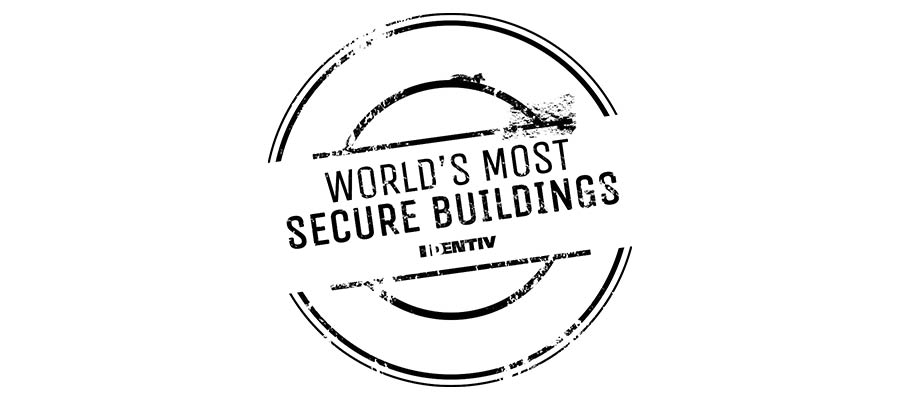The World’s Most Secure Buildings: The White House, Washington, D.C.
June 23, 2021
The White House is the formal office and residence of the president of the United States. Located at 1600 Pennsylvania Avenue N.W. in Washington, D.C, it is perhaps the most renowned and easily identifiable building in the world, serving as both the residence and workplace of the president and the headquarters of the president’s main staff members.
Since the administration of George Washington (1789 - 1797), every U.S. president has lived in the White House. On early maps, it was called the “President’s Palace” and was officially named the Executive Mansion in 1810 to avoid connotations of royalty. However, the name “White House” became official in 1901 when it was approved by President Theodore Roosevelt. Its premises occupy 18 acres (7.2 hectares).
It is the oldest federal building in the nation’s capital, but what makes the White House one of the world’s most secure buildings? Read on to find out.
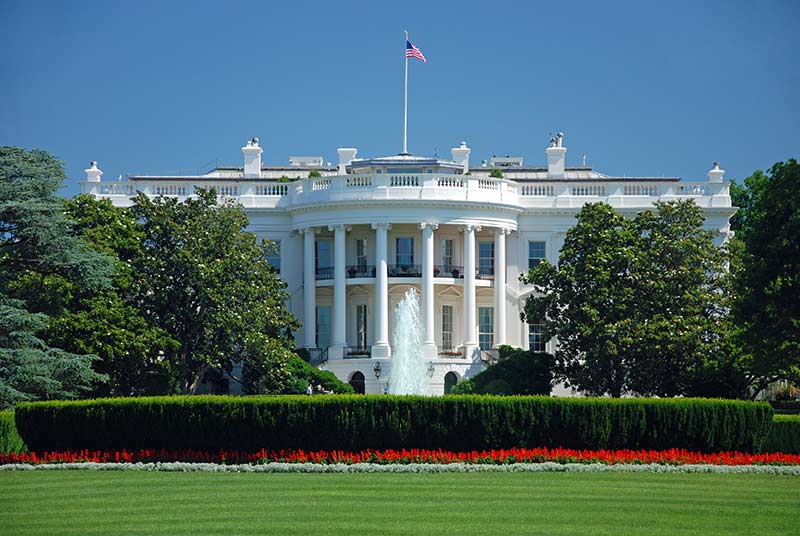
The White House
Construction of the White House, Washington, D.C
Although there is no record of a proper ceremony, construction of the White House started in October 1792 with the laying of the cornerstone. African-American laborers, employed Europeans, and several immigrants constructed the main residence and foundations of the building. The initial construction took place over eight (8) years, reportedly at a cost of $232,371.83. Even though it was not completed, the White House was ready for tenancy by November 1800.
The completed structure included only two main floors rather than the planned three and a low-cost brick served as a lining for the stone facades. Once the construction was over, the porous sandstone walls were whitewashed with a mixture of lime, rice glue, casein, and lead, giving the building its familiar color and name.
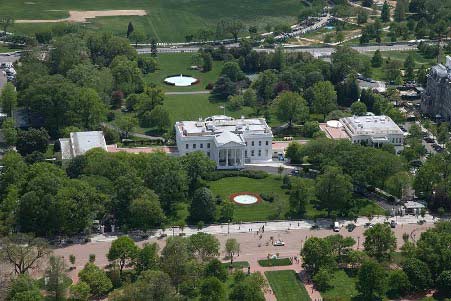
The White House
Facts About the White House, Washington, D.C
- There are 132 rooms, 35 bathrooms, and six (6) levels in the building. It has 412 doors, 147 windows, 28 fireplaces, eight (8) staircases, and three (3) elevators.
- The building requires 570 gallons of paint to cover its external surface.
- Several times in history, the White House was recognized as the “President’s Palace,” the “President’s House,” and the “Executive Mansion”.
- President Theodore Roosevelt officially gave the White House its existing name in 1901.
- The White House kitchen can serve dinner to as many as 140 guests and appetizers to over 1,000.
Facilities in the White House, Washington, D.C
The main building of the White House contains the presidential family’s living quarters and several reception rooms, all adorned in styles of the 18th and 19th centuries. Some parts of the main building can be accessed by the public. The west terrace includes the press briefing room and the east terrace contains a movie theater. The presidential office, known as the Oval Office, is situated in the West Wing, along with the cabinet and press rooms. The East Wing includes other offices.
Layout and Amenities
Today, the group of buildings housing the presidency is called the White House Complex. It includes the central Executive Residence bordered by the East Wing and West Wing. The Chief Usher manages daily household operations.
The White House has six (6) stories and 55,000 square feet of floor space, along with five (5) permanent chefs, a tennis court, a single-lane bowling alley, a movie theater (officially called the White House Family Theater), a jogging track, a swimming pool, and a putting green. It receives up to 30,000 visitors weekly.
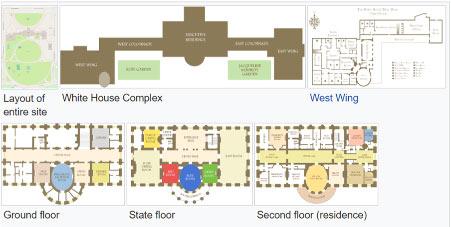
The White House Layout
Executive Residence
The original house is in the center. Two porches, one to the east and one to the west, serve to connect the East and West Wings. The Executive Residence contains the president's dwelling, along with rooms for ceremonies and official events.
- The State Floor of the residence building includes the East Room, Green Room, Blue Room, Red Room, State Dining Room, Family Dining Room, Cross Hall, Entrance Hall, and Grand Staircase.
- The Ground Floor is made up of the Diplomatic Reception Room, Map Room, China Room, Vermeil Room, Library, the main kitchen, and other offices.
- The Second Floor family residence includes the Yellow Oval Room, East and West Sitting Halls, the White House Master Bedroom, President's Dining Room, the Treaty Room, Lincoln Bedroom, and Queens' Bedroom, along with two additional bedrooms, a smaller kitchen, and a private dressing room.
- The Third Floor includes the White House Solarium, Game Room, Linen Room, a Diet Kitchen, and another living room (formerly used as President George W. Bush's workout room).
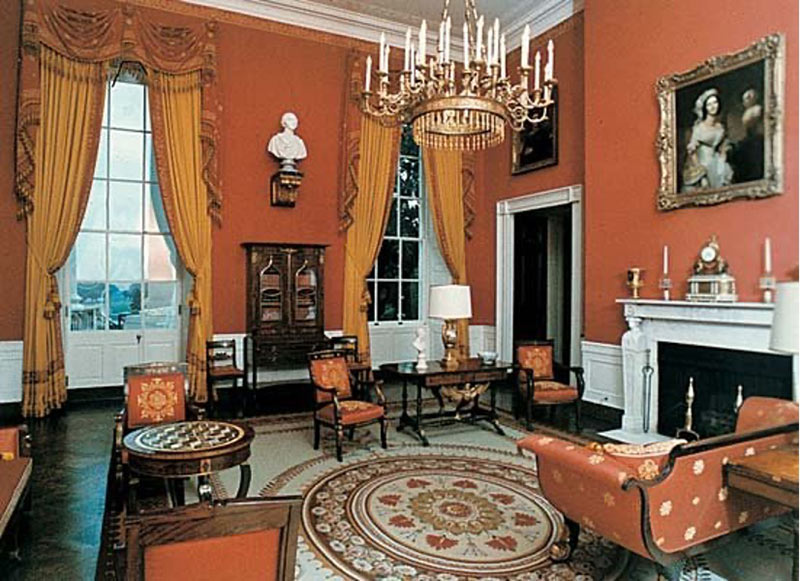
Red Room
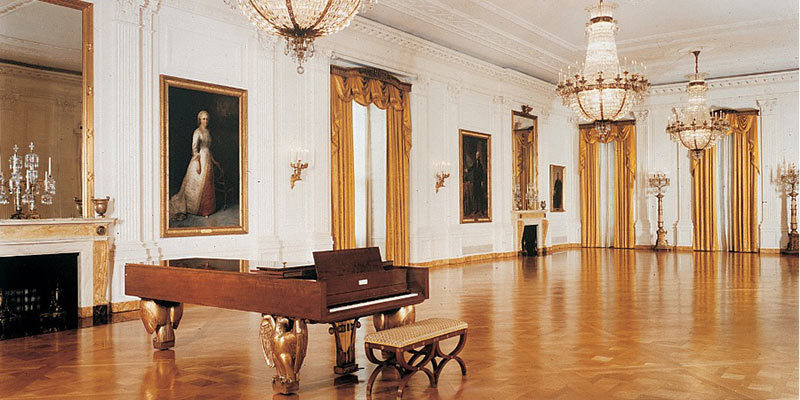
East Room
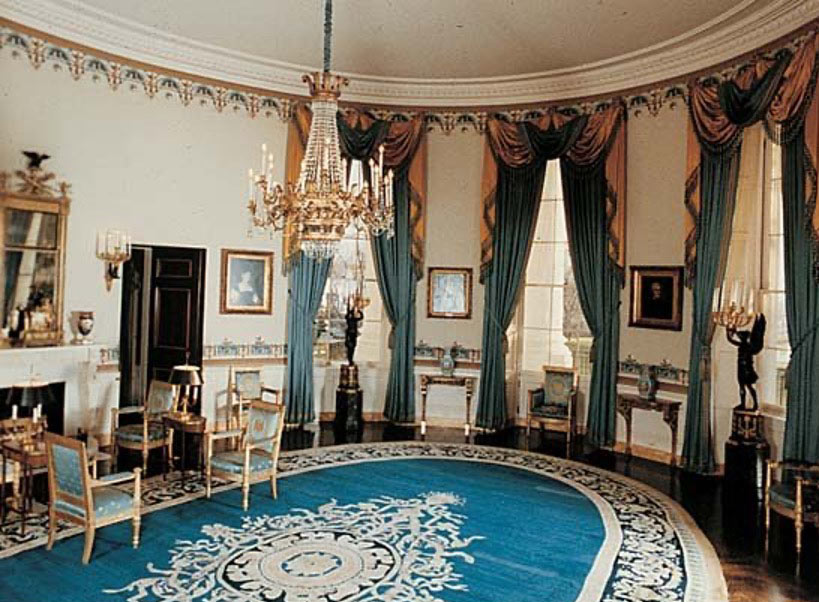
Blue Room
West Wing
The West Wing contains the president's office (the Oval Office) and offices of the senior staff, with room for about 50 employees. It also includes the Cabinet Room, where the president carries out business meetings and the Cabinet meets, as well as the White House Situation Room, James S. Brady Press Briefing Room, and Roosevelt Room.
In 2007, renovations to the press briefing room added fiber optic cables and LCD screens for the display of charts and graphs. The renovation took 11 months and cost $8 million, out of which news outlets paid $2 million. In September 2010, a two-year project started on the West Wing, constructing a multi story underground structure.
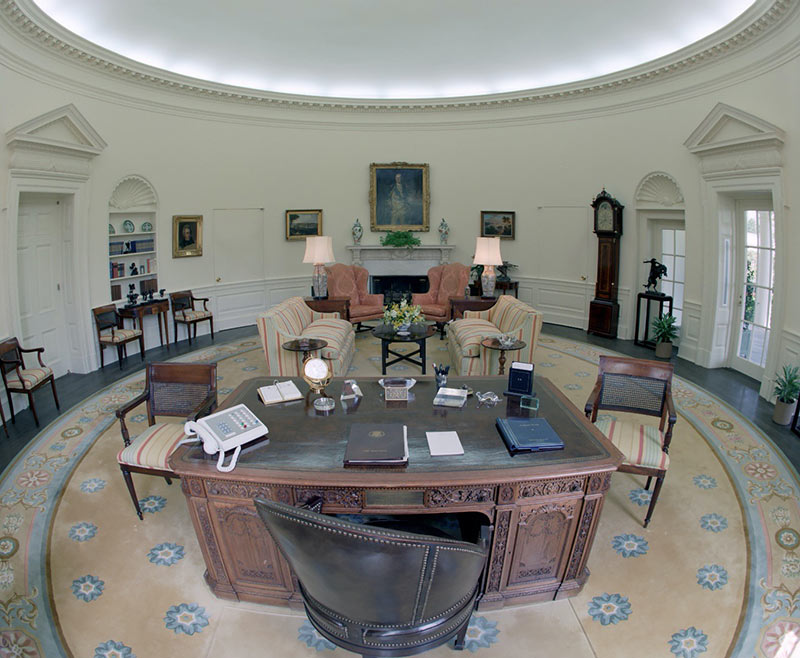
Oval Office
East Wing
The East Wing, which includes extra office space, was added to the White House in 1942. Among its uses, the East Wing occasionally housed the offices and staff of the first lady and the White House Social Office. In 1977, Rosalynn Carter was the first to place her personal office in the East Wing and to officially call it the "Office of the First Lady".
Constructed during World War II, the East Wing concealed the construction of an underground bunker to be used in crises. The bunker is now known as the Presidential Emergency Operations Center (PEOC).
Grounds
The White House grounds cover just over 18 acres. During the mid-to-late 19th century, a series of ever-larger greenhouses were constructed on the west side of the house where the current West Wing is situated.
The overall layout of the White House grounds today is based on the 1935 design by Frederick Law Olmsted Jr. of the Olmsted Brothers firm, commissioned by President Franklin D. Roosevelt. The premises include several gardens and lawns:
- North Lawn, planted with ornate carpet-style flowerbeds
- White House Rose Garden, bordering the West Colonnade
- Jacqueline Kennedy Garden, bordering the East Colonnade
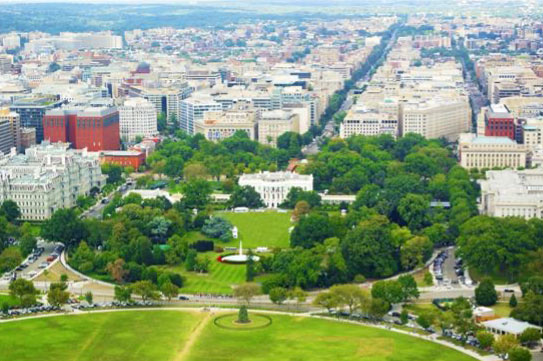
The White House
What Makes the White House, Washington, D.C, One of the World’s Most Secure Buildings?
One of the most distinguishable buildings in the world, the White House in Washington, D.C. employs a number of sophisticated measures to protect the President of the U.S. and their administration.
Although visitors can tour parts of the White House Complex, all bookings must be made in advance with at least 21 days’ notice to allow time for background checks. U.S. citizens must request access through their Congress members, although international visitors are recommended to contact their consulates.
The White House Complex lies at the center of a highly controlled, 15-mile flight restricted zone neighboring Ronald Reagan Washington National Airport. Many surface-to-air missile launchers are also situated across the city, ready to intercept any aircraft that does not abide by directions from the U.S. Air Force.
The building itself has a roof-mounted radar that meticulously monitors the area around the White House. The boundary of the White House is monitored by a range of infrared cameras capable of detecting the slightest temperature variation and alerting security to any possible threats.
Although most of the White House defenses function hidden from public view, the fence surrounding the entire premises offers impressive protection. Standing 2.1 meters (7 feet) tall over crash-resistant concrete footings, the wrought iron fence is topped with a series of barbs to prevent creepers.
In 2017, staff increased the height of the fence to 3.3 meters (10.8 feet) and fixed the fence with sensors to alert security employees when pressure is applied to the bars. Bullet-proof windows can resist numerous direct impacts from semi-automatic weapons.
The PEOC and the Situation Room, positioned under the East and West Wings, can continue operation even in the event of a nuclear explosion.
The White House Complex is sheltered by the U.S. Secret Service and the U.S. Park Police. Norwegian Advanced Surface to Air Missile System (NASAMS) protected airspace over Washington, D.C. during the 2005 presidential inauguration. The same NASAMS units continue defending the president and all airspace around the White House, which is strictly prohibited to aircraft.
Secure Your Building With Identiv
Identiv’s flexible
physical access control system (PACS) and
video intelligence solutions provide the highest security at the lowest cost possible. No matter where you are physically located, you can easily manage access control through our robust, feature-rich systems, hardware, and software. To learn more about our PACS solutions, contact us at +1 888.809.8888 or sales@identiv.com.
